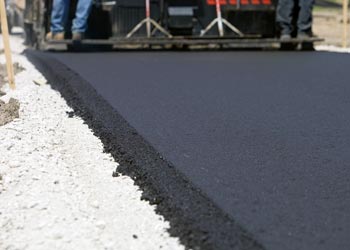Some Known Facts About A1 Professional Asphalt & Sealing Llc.
Table of ContentsIndicators on A1 Professional Asphalt & Sealing Llc You Should KnowSome Known Facts About A1 Professional Asphalt & Sealing Llc.Unknown Facts About A1 Professional Asphalt & Sealing LlcThe Definitive Guide to A1 Professional Asphalt & Sealing LlcHow A1 Professional Asphalt & Sealing Llc can Save You Time, Stress, and Money.

The oil in a vehicle engine is not simply oil. It consists of a variety of additives to boost the car's efficiency. These include polymers, thickness modifiers, heat stabilizers, additional lubricating substances, and wear ingredients. The REOB includes all the ingredients that were in the waste oil along with the wear metals from the engine (mostly iron and copper).
By making numerous blends utilizing various REOB examples and various asphalt binders, the variants mostly can be balanced out. Numerous States supplied examples of well-known REOB composition to TFHRC researchers, who examined the samples to contrast the portion of added (recognized) REOB to the located (examined) amount. The evaluations revealed a comparable percentage of included and located REOB.
Not known Incorrect Statements About A1 Professional Asphalt & Sealing Llc
They got an overwhelming response. The TFHRC researchers evaluated 1,532 samples from 40 States, one Canadian district, and 2 Federal Lands Highway departments. They evaluated each sample twiceamounting to more than 3,000 analyses. None of those States realized that the asphalt they were getting consisted of REOB. One State insisted its examples had no REOB.
Of the 1,532 samples examined, 12 percent contained REOB, and some consisted of significantly high degrees of it at 1020 percent. The highest degree was 34 percent in a sample from Texas, which TxDOT had used in a patching compound. This testing additionally disclosed the presence of phosphoric acid in 11 percent of the samples, and 2 percent consisted of ground tire rubber.
2 years back at TRB's yearly conference, the Federal researchers held an REOB workshop and presented the findings of their research laboratory analyses to a standing room-only group. Although some firms do not particularly ban REOB, they do enforce physical examinations that preclude its useeffectively a restriction. a1 professional. Others do not outlaw it by spec, but have agreements with asphalt vendors to avoid making use of REOB
A1 Professional Asphalt & Sealing Llc for Dummies
A handful do enable REOB, some within specific restrictions. For instance, Ohio and Texas restriction levels to less than 5 percent of the asphalt. To establish a trustworthy test method that all States can utilize, the TFHRC scientists established up a round-robin examination plan. The participants are 11 State highway agencies (Illinois, Massachusetts, Minnesota, Mississippi, Montana, North Carolina, Oklahoma, South Carolina, Texas, Vermont, and Wyoming), 2 independent testing labs, the Ministry of Transportation in Ontario, Queen's College in Ontario, and an Ontario paving contractor.
The individuals are evaluating the samples individually utilizing the guidelines offered by the TFHRC researchers. The result will be a proposed AASHTO examination technique that any type of State can adopt and use.
The pavement with REOB, which is situated 0.6 mile (1 kilometer) from the pavement without REOB, has the same subgrade, traffic density, and climate. Nonetheless, the segment of Highway655 with 5 to 10 percent REOB showed substantial breaking. In this example, the visibility of REOB was the identified reason for splitting at a low temperature levels.
"In our experience in copyright, also little quantities of 23 percent can be a trouble." A section of test sidewalk in Minnesota (MN1-4) found to include REOB additionally broke prematurely. The sidewalk performed well for the very first 3 to 4 years, but after that began to fracture. This pavement is likewise based on reduced temperatures.
Rumored Buzz on A1 Professional Asphalt & Sealing Llc
The tests were not substantial, however they revealed that at levels of 6 percent or even more, the tensile strength of the asphalt dropped considerably. At a level of 3.5 percent REOB, the variation in the physical examination methods was above the effect of REOB. Actually, it was tough for researchers to analyze whether REOB was existing.

One binder criterion considered is the distinction in between the reduced temperature level essential requirements temperature level for stiffness (S) in the flexing beam of light rheometer and the bending beam of light rheometer creep incline (m-value) noted as Tcritical. TC = TC dig this (S) TC (m-value). Evaluation of this criterion is still ongoing. Two independent study groups, one from AASHTO and the various other from the Asphalt Institute, wrapped up that more research study is needed on the usage of REOB in asphalt.
Previously, all asphalt screening determined engineering homes such as stiffness. These examinations do not show what products had been added to the asphalt. One example received throughout the TFHRC research had an extremely unusual analysis. The example had the complying with examination results: Superpave PG 64-28 with a high temperature level grade of 67.3 Tcritical on the flexing light beam rheometer was 6.7 degrees Celsius.

The 45-Second Trick For A1 Professional Asphalt & Sealing Llc
These results demonstrate there are weaknesses in the standardized design testing methods that might be made use of. The manufacturer may have an economic advantage and the product passes all the standardized examinations, however the item might not be beneficial to making certain lasting efficiency. To address this problem and the growth of new asphalt ingredients and extenders, TFHRC is starting a study program to make use of handheld spectroscopic gadgets, x-ray fluorescence spectroscopy, and Fourier transform infrared spectroscopy to make it possible for evaluations to be done in the area instead of needing to take samples back to the laboratory.